Ballistic Performance of Thermoplastic Fiber-Reinforced Metal Laminates Subjected to Impact Loadings
Abstract
1. Introduction
2. Dynamic Constitutive Model for 2024-T3 Aluminum Alloy
2.1. Strength Model
2.2. Failure Criteria
3. Formulation of Finite Element Model
3.1. Finite Element Model
3.2. Determination of Various Parameters
4. Results and Discussion
4.1. Comparisons with Available Test Data
4.2. Effect of Projectile Nose Shape
5. Conclusions
- (1)
- The present model predicts the experimental results well for TFMLs subjected to impact by hemispheric-nosed projectiles in terms of perforation energy, cross-sectional deformation, and failure patterns at various impact energies.
- (2)
- It has been demonstrated that the nose shape of projectiles significantly influences the perforation behavior of TFMLs in terms of both residual velocity and damage patterns. This is attributable to the distinct deformation mechanisms induced by each projectile type. Specifically, flat-ended projectiles exhibit the highest residual velocities, whereas ogival-nosed projectiles exhibit the lowest.
- (3)
- The present model exhibits an enhanced performance regarding failure patterns when compared to existing models, such as the elastoplastic constitutive model and the JC + BW constitutive model, despite yielding comparable deformation results.
Author Contributions
Funding
Institutional Review Board Statement
Informed Consent Statement
Data Availability Statement
Conflicts of Interest
Abbreviations
| TFMLs | thermoplastic fiber-reinforced metal laminates |
| VUMAT | vectorized user material subroutine |
| JC | Johnson–Cook |
| PP/PP | polypropylene fiber-reinforced polypropylene matrix composites |
| DIF | Dynamic Increase Factor |
| FE | finite element |
References
- Das, R.; Chanda, A.; Brechou, J.; Banerjee, A. Impact behaviour of fibre–metal laminates. In Dynamic Deformation, Damage and Fracture in Composite Materials and Structures; Silberschmidt, V.V., Ed.; Woodhead Publishing: Cambridge, UK, 2016; pp. 491–542. [Google Scholar]
- Xie, M.; Zhan, L.; Ma, B.; Hui, S. Classification of fiber metal laminates (FMLs), adhesion theories and methods for improving interfacial adhesion: A review. Thin-Walled Struct. 2024, 198, 111744. [Google Scholar] [CrossRef]
- Guo, Y.; Xu, X.; Chen, Z.; Yin, H.; Li, F. Deformation mechanisms and Surface/Interface characteristics of titanium-based thermoplastic FMLs under ultrasonic impact loading. Ultrasonics 2024, 138, 107217. [Google Scholar] [CrossRef]
- Sang, L.; Xing, J.; Lv, J.; Gao, S.; Hou, W. Investigation of structure–flexural response relations in thermoplastic carbon/glass fiber-metal laminates. Polym. Compos. 2024, 45, 5619–5632. [Google Scholar] [CrossRef]
- Mahesh, V. Comparative study on low velocity impact response of carbon-fiber-reinforced polymer/thermoplastic elastomer based fiber metal laminates with and without interleaving of elastomeric layer. J. Thermoplast. Compos. Mater. 2024, 37, 604–624. [Google Scholar] [CrossRef]
- Santiago, R.; Cantwell, W.; Alves, M. Impact on thermoplastic fibre-metal laminates: Preliminary results and observations. In Proceedings of the International Symposium on Solid Mechanics, Porto Alegre, Brazil, 18–19 April 2013. [Google Scholar]
- Liu, Y.J.; Wang, Z.H.; Wen, H.M. Predicting the response and perforation of fibre metal laminates subjected to projectile impact. Aircraft Eng. Aerospace Technol. 2022, 94, 163–175. [Google Scholar] [CrossRef]
- Santiago, R.; Cantwell, W.; Alves, M. Impact on thermoplastic fibre-metal laminates: Experimental observations. Compos. Struct. 2017, 159, 800–817. [Google Scholar] [CrossRef]
- Yang, L.; Liao, Z.; Qiu, C.; Hong, Z.; Yang, J. Experimental study on the impact resistance and damage tolerance of thermoplastic FMLs. Thin-Walled Struct. 2024, 196, 111435. [Google Scholar] [CrossRef]
- Abdullah, M.R.; Cantwell, W.J. The Impact Resistance of Fiber-metal Laminates Based on Glass Fiber Reinforced Polypropylene. Polym. Compos. 2006, 27, 700–708. [Google Scholar] [CrossRef]
- Majzoobi, G.H.; Morshedi, H.; Farhadi, K. The effect of aluminum and titanium sequence on ballistic limit of bi-metal 2/1 FMLs. Thin Wall Struct. 2018, 122, 1–7. [Google Scholar] [CrossRef]
- Zhou, J.; Guan, Z.W.; Cantwell, W.J. The influence of strain-rate on the perforation resistance of fiber metal laminates. Compos. Struct. 2015, 125, 247–255. [Google Scholar] [CrossRef]
- Lissner, M.; Alabort, E.; Cui, H.; Rito, R.; Blackman, B.R.K.; Petrinic, N. Experimental characterisation and numerical modelling of the influence of bondline thickness, loading rate, and deformation mode on the response of ductile adhesive interfaces. J. Mech. Phys. Solids 2019, 130, 349–369. [Google Scholar] [CrossRef]
- Guan, Z.; Cantwell, W.; Abdullah, R. Numerical modeling of the impact response of fiber–metal laminates. Polym. Compos. 2009, 30, 603–611. [Google Scholar] [CrossRef]
- Linde, P.; Pleitner, J.; de Boer, H.; Carmone, C. Modelling and simulation of fibre metal laminates. In Proceedings of the ABAQUS Users’ Conference, Boston, MA, USA, 25–27 May 2004. [Google Scholar]
- Sadighi, M.; Pärnänen, T.; Alderliesten, R.C.; Sayeaftabi, M.; Benedictus, R. Experimental and Numerical Investigation of Metal Type and Thickness Effects on the Impact Resistance of Fiber Metal Laminates. Appl. Compos. Mater. 2012, 19, 545–559. [Google Scholar] [CrossRef]
- Yu, G.C.; Wu, L.Z.; Ma, L.; Xiong, J. Low velocity impact of carbon fiber aluminum laminates. Compos. Struct. 2015, 119, 757–766. [Google Scholar] [CrossRef]
- Karagiozova, D.; Langdon, G.S.; Nurick, G.N.; Yuen, S.C.K. Simulation of the response of fibre-metal laminates to localised blast loading. Int. J. Impact Eng. 2010, 37, 766–782. [Google Scholar] [CrossRef]
- Zhu, Q.; Zhang, C.; Curiel-Sosa, J.L.; Bui, T.Q.; Xu, X. Finite element simulation of damage in fiber metal laminates under high velocity impact by projectiles with different shapes. Compos. Struct. 2019, 214, 73–82. [Google Scholar] [CrossRef]
- Zhou, L.; Wang, Z.H.; Wen, H.M. On the Accuracy of the Johnson-Cook Constitutive Model for Metals. Chin. J. High. Press. Phys. 2019, 33, 042101. [Google Scholar]
- Zhou, L.; Wen, H.M. A New Approach for the Failure of Metallic Materials. Chin. J. High. Press. Phys. 2019, 33, 014103. [Google Scholar]
- Zhou, L.; Wen, H.M. A new Dynamic Plasticity and Failure Model for Metals. Metals 2019, 9, 905. [Google Scholar] [CrossRef]
- Abdullah, M.R.; Cantwell, W.J. The impact resistance of polypropylene-based fibre-metal laminates. Compos. Sci. Technol. 2006, 66, 1682–1693. [Google Scholar] [CrossRef]
- Bai, Y.; Wierzbicki, T. A new model of metal plasticity and fracture with pressure and Lode dependence. Int. J. Plast. 2008, 24, 1071–1096. [Google Scholar] [CrossRef]
- Seidt, J.; Gilat, A. Plastic deformation of 2024-T351 aluminum plate over a wide range of loading conditions. Int. J. Solids Struct. 2013, 50, 1781–1790. [Google Scholar] [CrossRef]
- Moriniere, F.D.; Alderliesten, R.C.; Benedictus, R. Low-velocity impact energy partition in GLARE. Mech. Mater. 2013, 66, 59–68. [Google Scholar] [CrossRef]
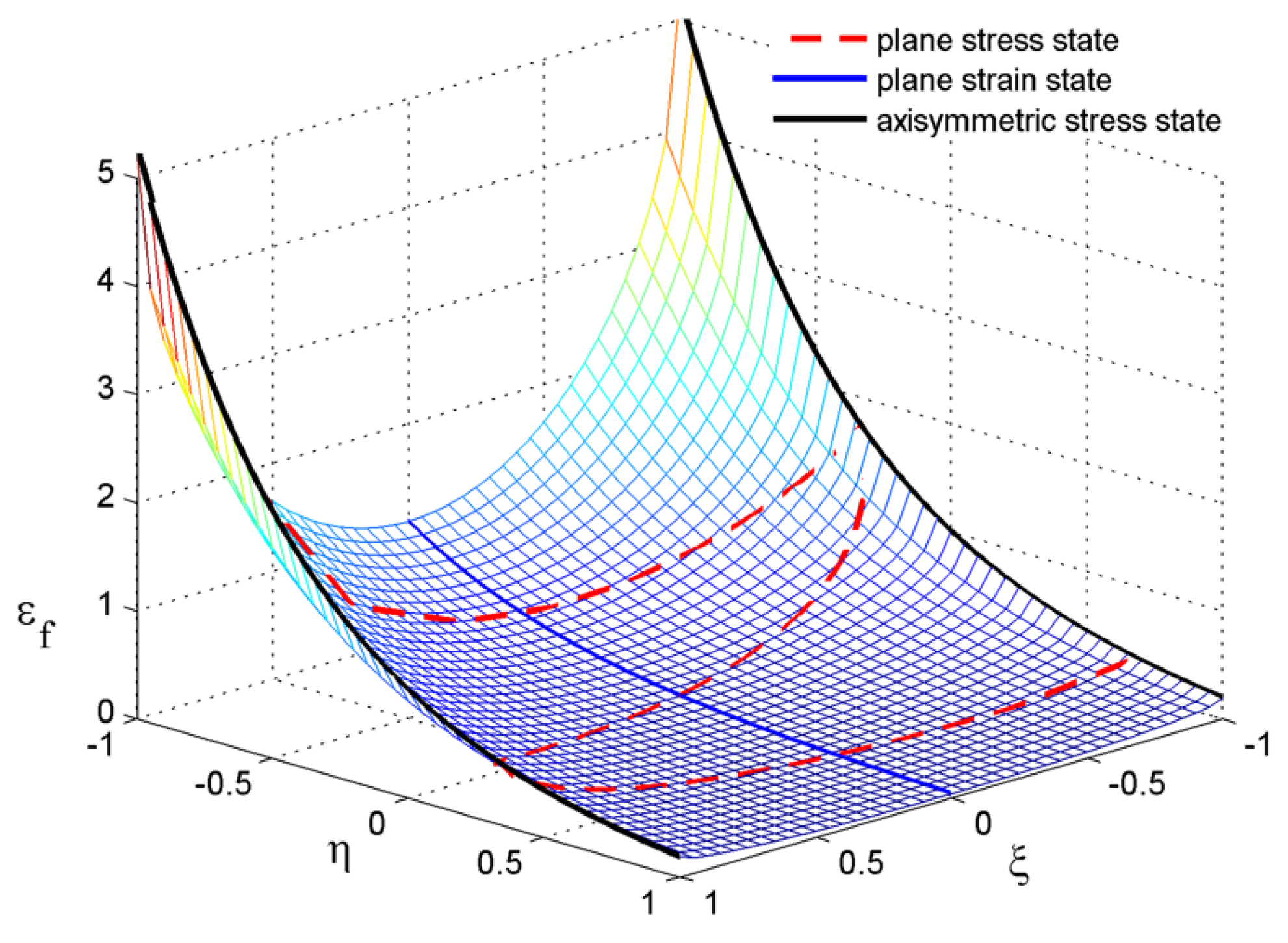

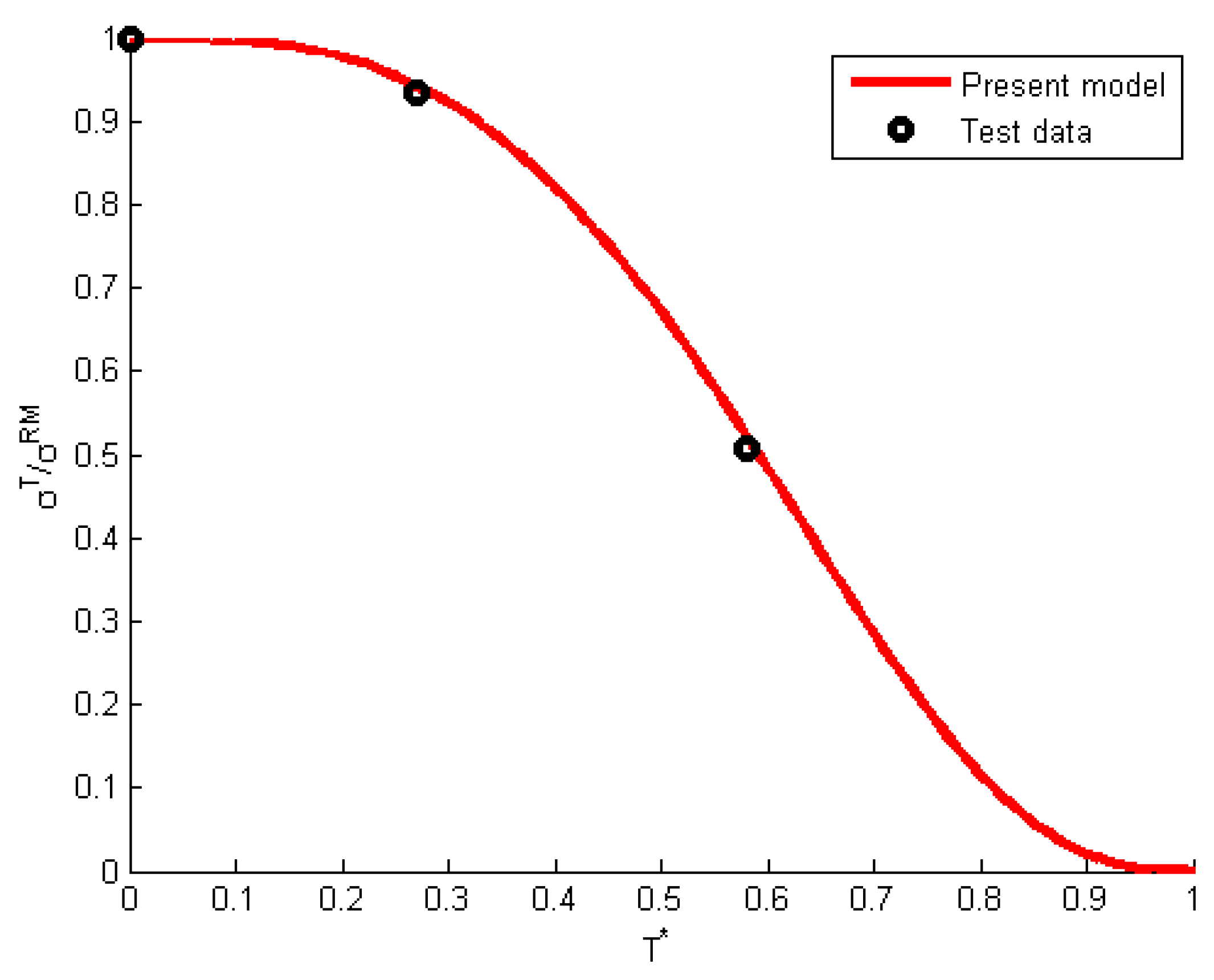

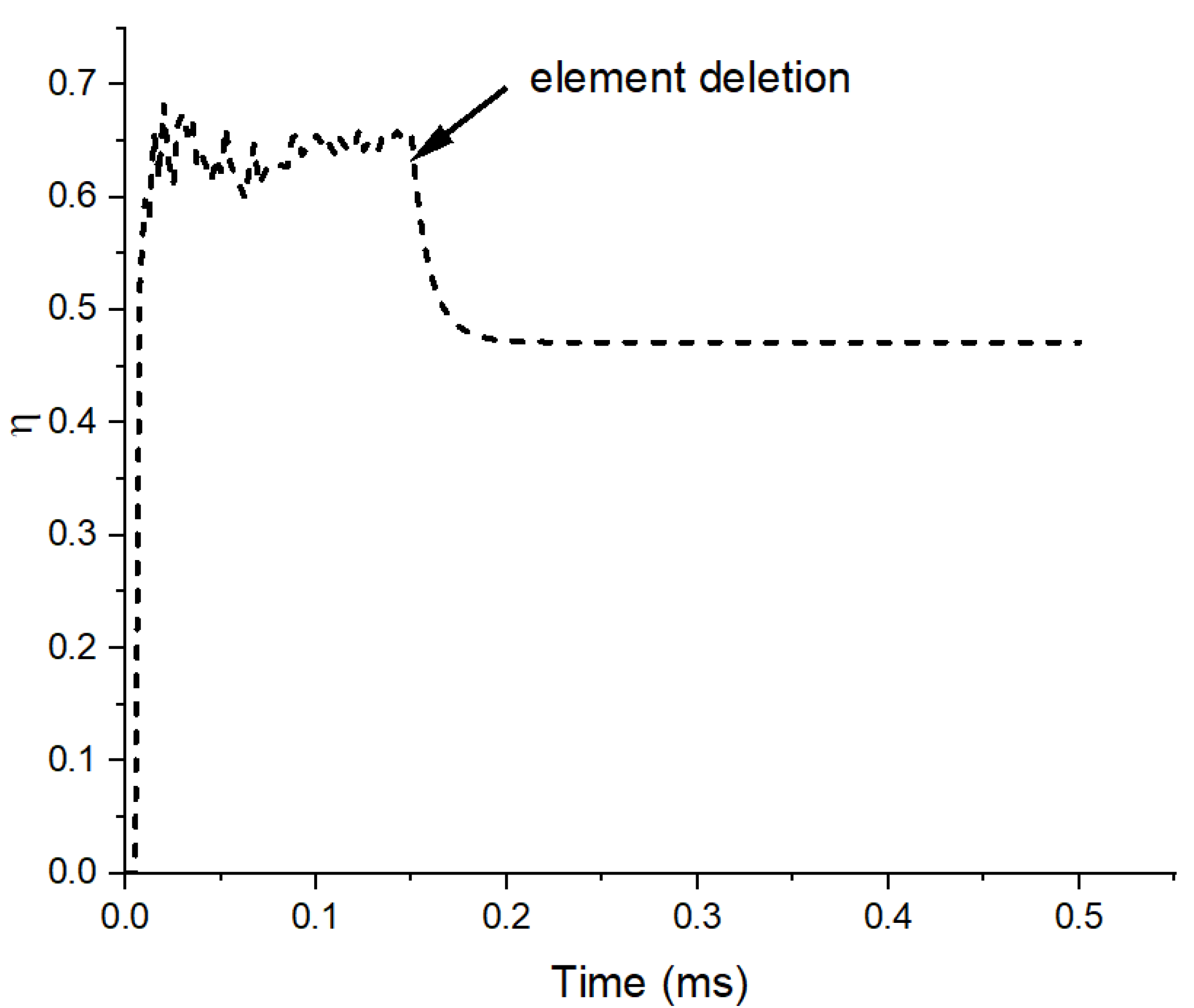

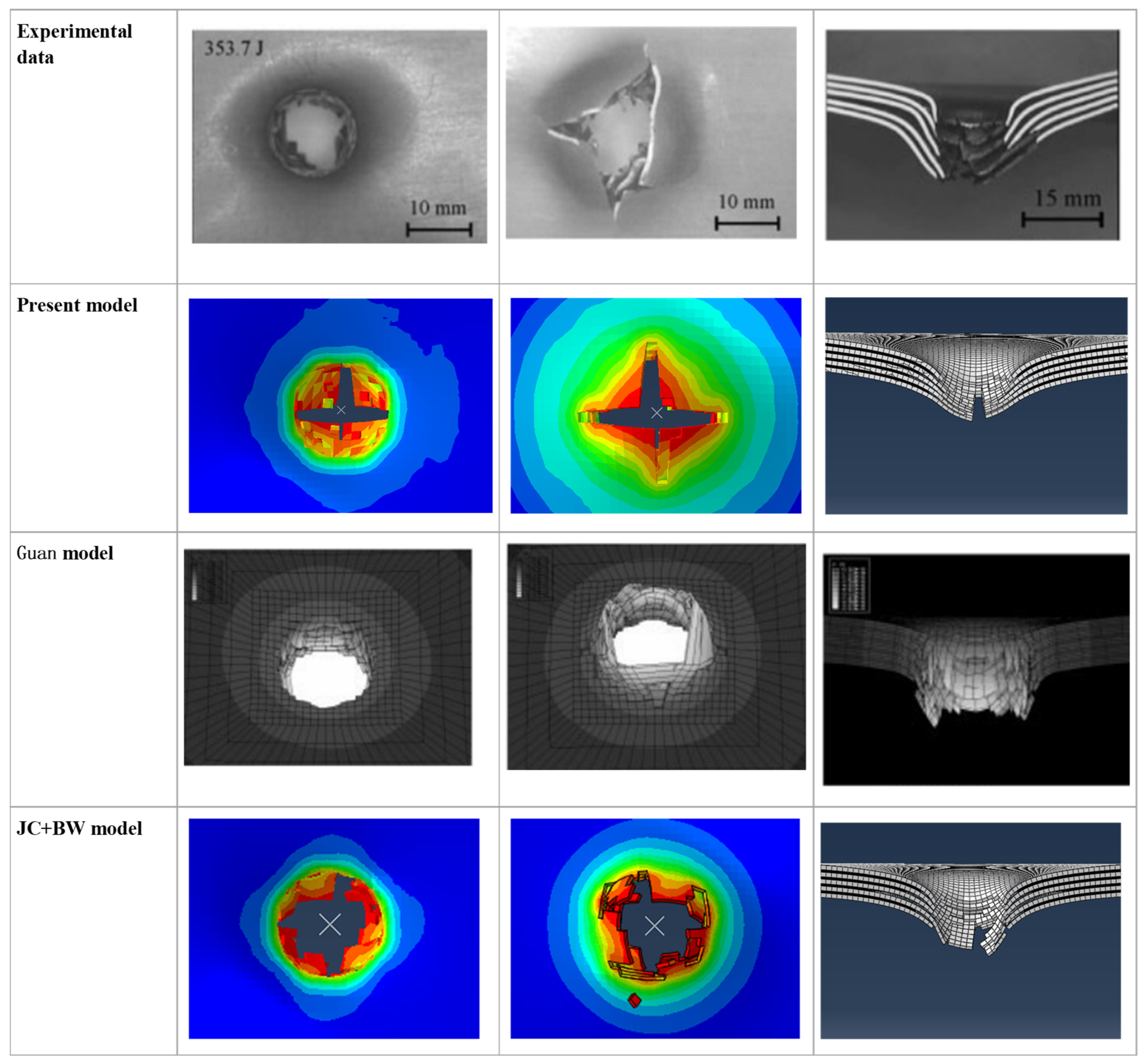
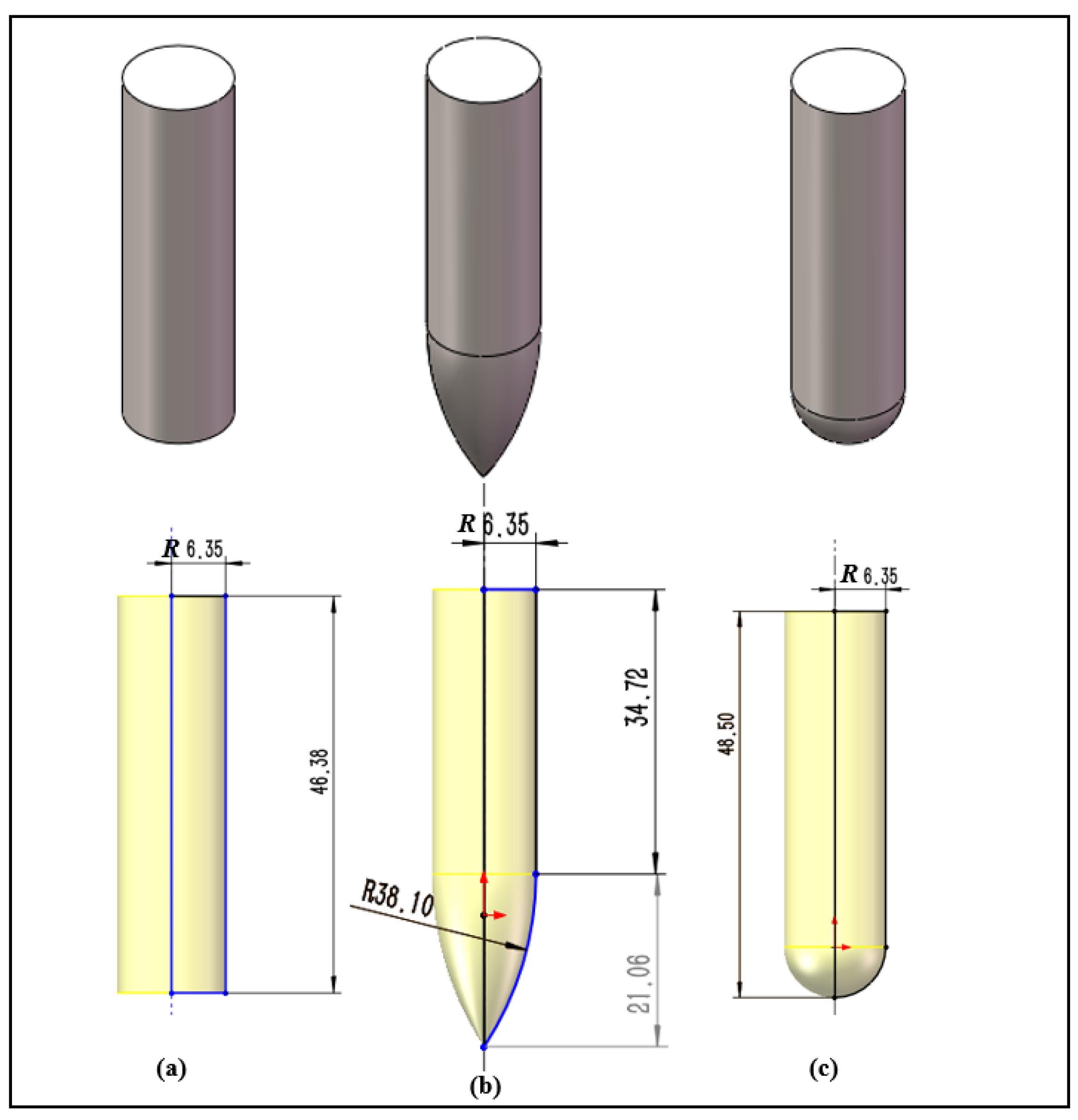
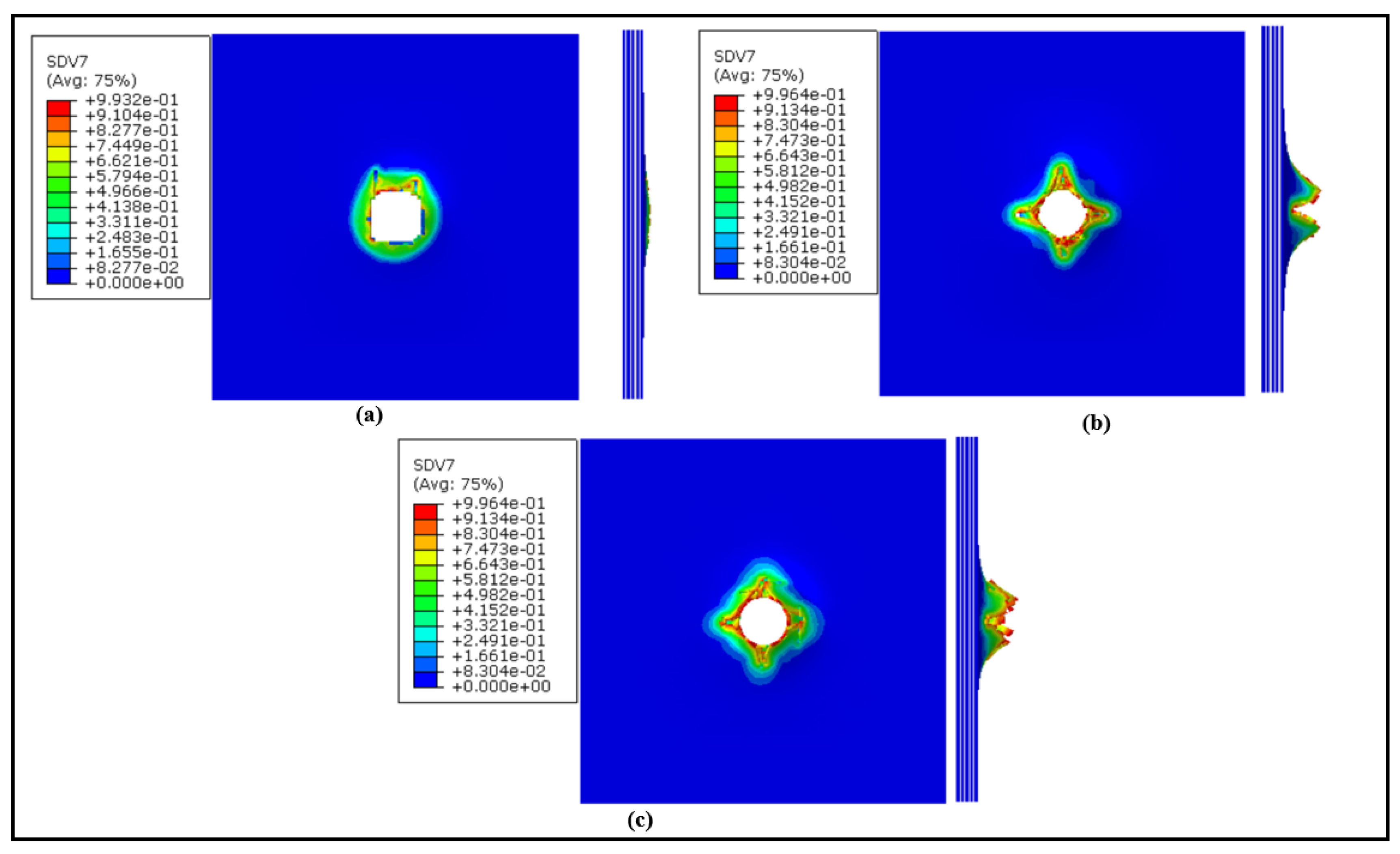
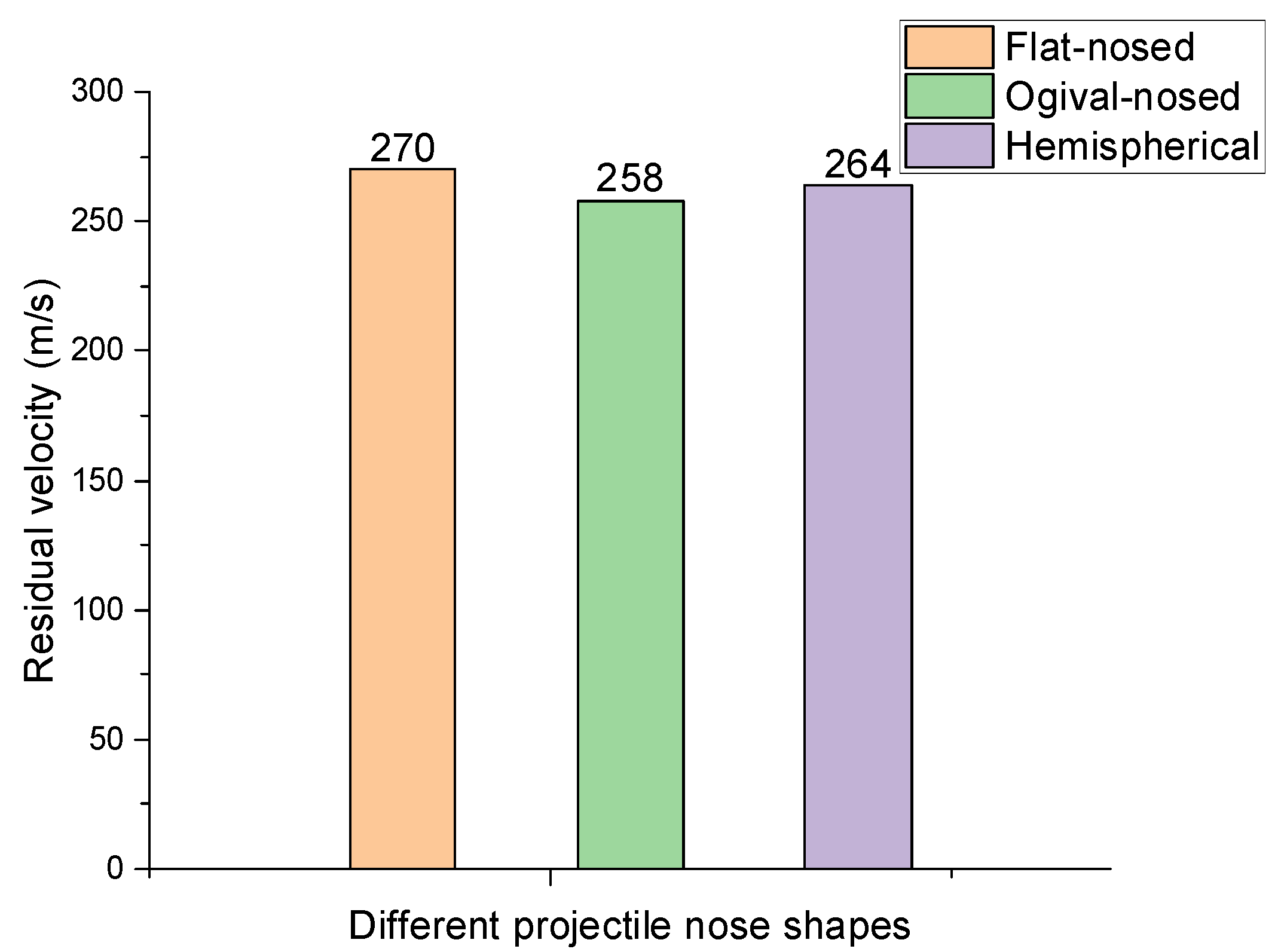
| Basic parameters | ρ (kg/m3) | E (GPa) | v | Tm (K) | Ta (K) | χ | Cp (J/kgK) |
| 2700 | 72 | 0.3300 | 775 | 293 | 0.9000 | 875 | |
| Equation of state | C0 (m/s) | S1 | Γ0 | ||||
| 5328 | 1.3380 | 2 | |||||
| Strength model | At (MPa) | Bt (MPa) | nt | As (MPa) | Bs (MPa) | ns | Wx |
| 369 | 684 | 0.7300 | 369 | 684 | 0.7300 | 4.1550 | |
| By | Wy | S | m1 | m2 | |||
| 100 | 1.3481 | 2.0922 | 9.0 × 10−5 | 0.0750 | 3.0 | 3.0 | |
| Failure criterion | C1 | C2 | C3 | C4 | |||
| 1.0055 | 0.21 | 0.011 | 0 |
Disclaimer/Publisher’s Note: The statements, opinions and data contained in all publications are solely those of the individual author(s) and contributor(s) and not of MDPI and/or the editor(s). MDPI and/or the editor(s) disclaim responsibility for any injury to people or property resulting from any ideas, methods, instructions or products referred to in the content. |
© 2024 by the authors. Licensee MDPI, Basel, Switzerland. This article is an open access article distributed under the terms and conditions of the Creative Commons Attribution (CC BY) license (https://creativecommons.org/licenses/by/4.0/).
Share and Cite
Zeng, Y.; Li, C.; Zheng, H.; Liu, Y. Ballistic Performance of Thermoplastic Fiber-Reinforced Metal Laminates Subjected to Impact Loadings. Appl. Sci. 2024, 14, 9157. https://doi.org/10.3390/app14209157
Zeng Y, Li C, Zheng H, Liu Y. Ballistic Performance of Thermoplastic Fiber-Reinforced Metal Laminates Subjected to Impact Loadings. Applied Sciences. 2024; 14(20):9157. https://doi.org/10.3390/app14209157
Chicago/Turabian StyleZeng, Yan, Chunguang Li, Hong Zheng, and Yijun Liu. 2024. "Ballistic Performance of Thermoplastic Fiber-Reinforced Metal Laminates Subjected to Impact Loadings" Applied Sciences 14, no. 20: 9157. https://doi.org/10.3390/app14209157
APA StyleZeng, Y., Li, C., Zheng, H., & Liu, Y. (2024). Ballistic Performance of Thermoplastic Fiber-Reinforced Metal Laminates Subjected to Impact Loadings. Applied Sciences, 14(20), 9157. https://doi.org/10.3390/app14209157







